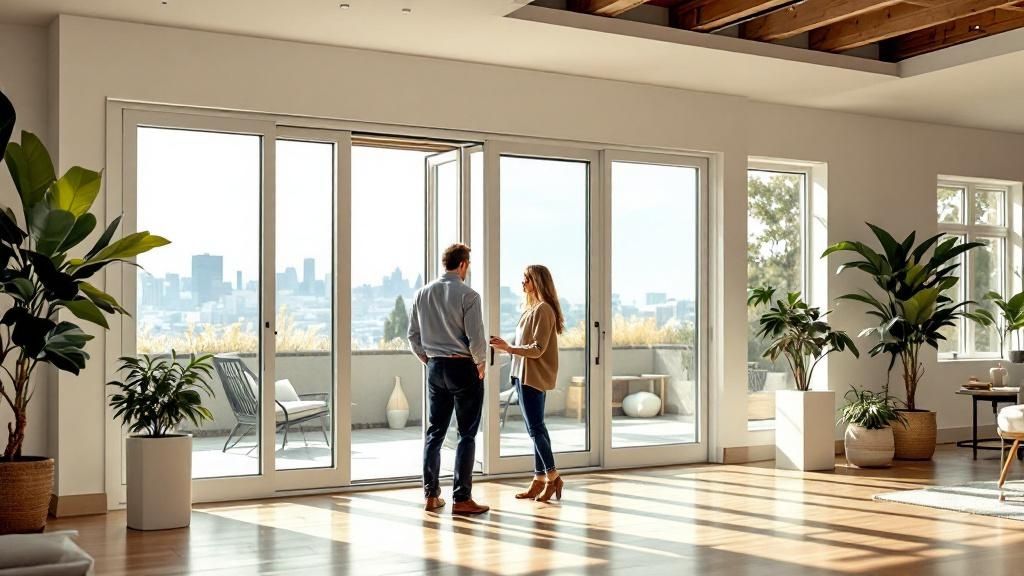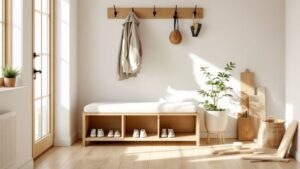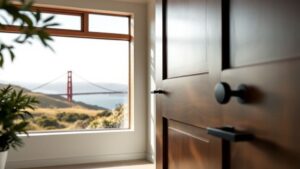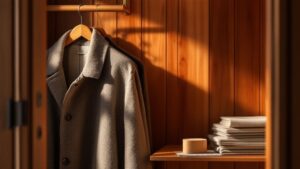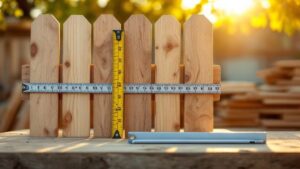You can spend hours flipping through catalogs and browsing online galleries, but nothing replaces an in-person visit when choosing windows and doors. To truly feel the quality, you must see, touch, and operate the products yourself. A visit to a quality windows and door showroom is the only way to ensure your final choices are a perfect fit for your project's aesthetic and functional needs.
Why a Showroom Visit Is Essential for Your Bay Area Project
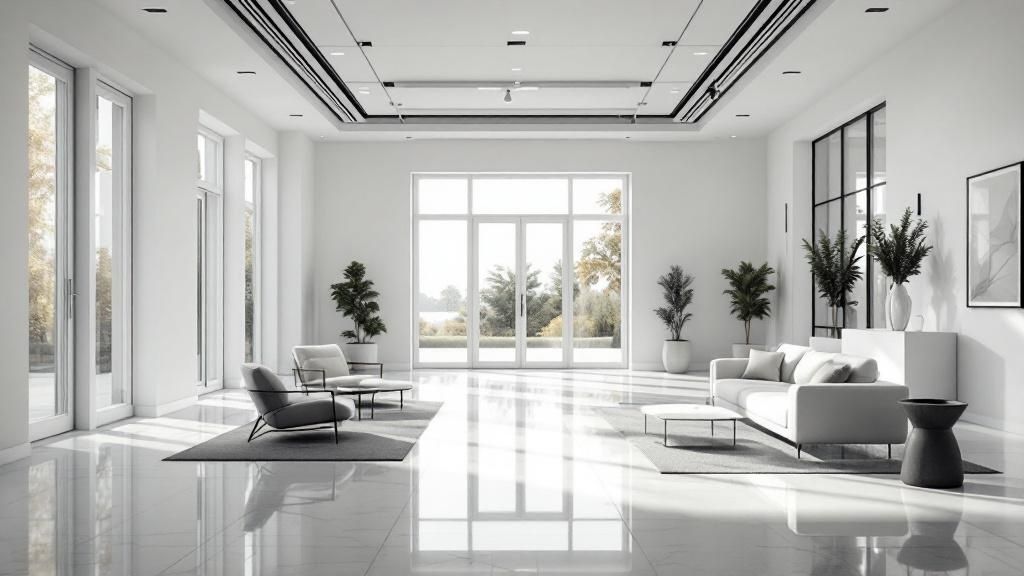
Image caption: A well-lit quality windows and door showroom featuring a variety of styles for Bay Area homes.
Pictures can be deceiving, which is why a trip to a showroom is so critical for builders, architects, and homeowners in the Bay Area. Our region features a unique mix of architectural styles, from historic Craftsman homes in Berkeley to sleek, modern lofts in Oakland. Seeing products in person is the best way to prevent a costly mismatch and ensure your selections match your vision.
Experience Quality and Craftsmanship Firsthand
A spec sheet can't convey the effortless glide of a Marvin sliding door or how light catches the grain on a real wood window. In a showroom, you get to put products to the test.
- Feel the difference: How smooth is the operation? What is the weight and feel of the hardware?
- Compare materials up close: See how different finishes and colors look in person, not just on a screen.
- Judge the build quality: You can see and feel the sturdiness of the frames and the precision of the construction.
This hands-on evaluation provides a deep understanding of the craftsmanship you’re investing in. It's about ensuring you get lasting value. A comprehensive construction project communication plan is just as vital for keeping larger projects on track.
Gain Clarity on Performance and Bay Area Code Compliance
The window and door industry is booming, with the North American market valued at over $41.5 billion in 2024, according to industry reports. With so many options, expert guidance is more important than ever.
A well-curated showroom is your best resource for navigating the complex choices tied to the Bay Area’s specific climate and strict building codes. Talking with an expert helps you understand which products can handle our coastal moisture or block out urban noise.
This is also your chance to get straight answers on California's Title 24 compliance. It’s one thing to read about glazing and U-factors, but it’s another to have an expert show you exactly how they contribute to energy efficiency. For a deeper dive, our guide on energy-efficient windows for Bay Area homes is a great place to start.
Ultimately, a visit to our Berkeley showroom gives you the clarity and confidence you need to make the right call for your home.
What Separates a Great Showroom from an Average One
Not all showrooms are created equal. Any business can display a few windows, but a truly quality windows and door showroom becomes a genuine partner in your project. The difference isn't just about what's on the floor; it's in the details that make your job easier and your project better.
A top-tier showroom invests heavily in its product selection. You should be able to walk in and compare top brands like Marvin and Andersen side-by-side. The best showrooms will have a broad range of materials on display—from classic wood and durable fiberglass to sleek, modern aluminum. This variety is crucial because it allows you to make direct, hands-on comparisons, which is the only way to make a truly informed decision for your project.
You need to see, touch, and operate these products to understand how they’ll perform on a job site.
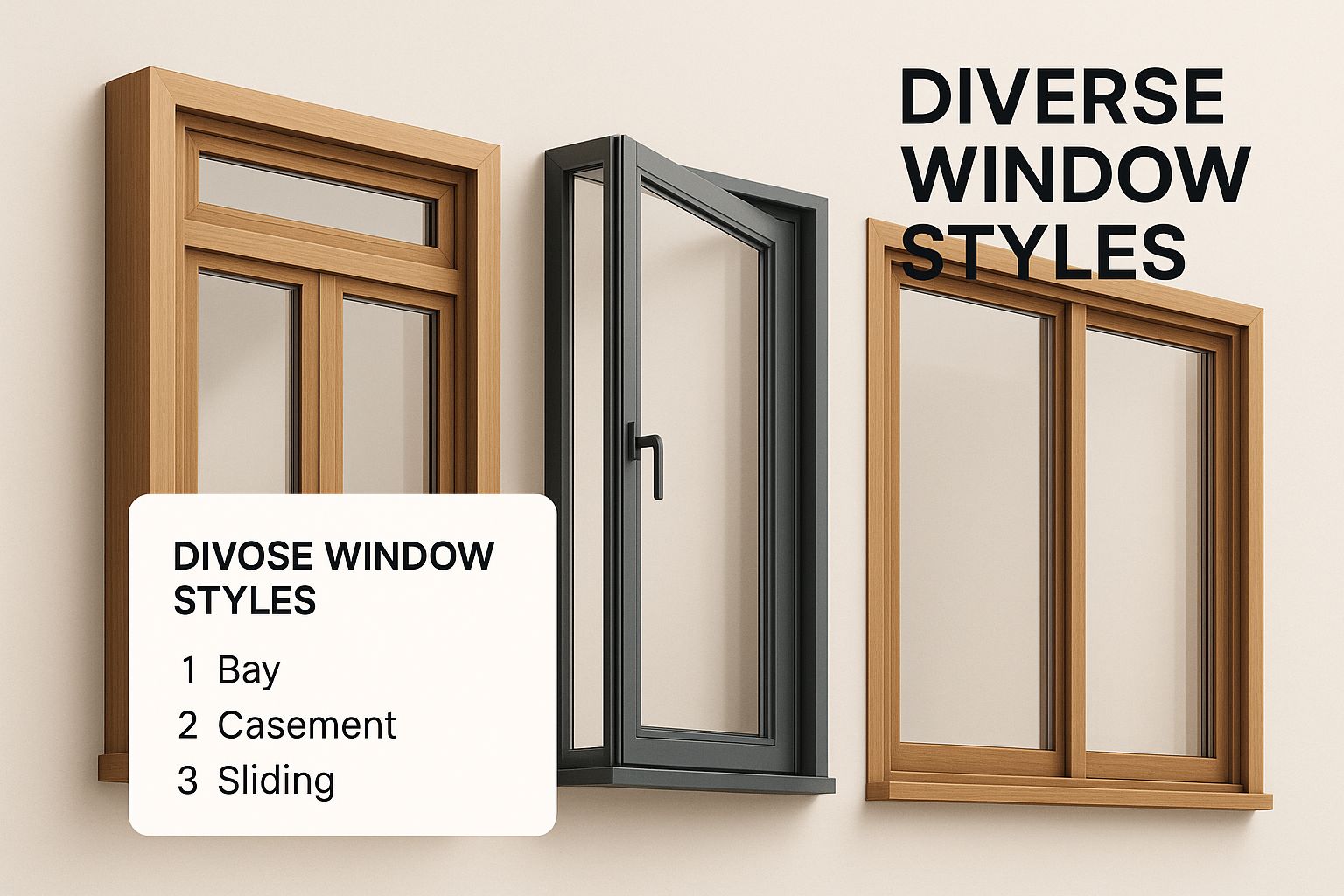
Image caption: A side-by-side comparison of different window frame materials and operating styles in a showroom setting.
As the image shows, the frame material and operating style completely change the architectural feel. Seeing this in person is so much more powerful than looking at a catalog.
Knowledgeable Staff with Local Bay Area Expertise
Here’s what really separates the good from the great: the people. An average salesperson might just rattle off features from a brochure. An expert consultant understands the real-world challenges of building in the Bay Area.
You can tell you're talking to a pro when they start asking you questions.
- Noise Abatement: For a home backing up to a busy street in Berkeley or Oakland, they won't just sell you a "quiet" window. They'll recommend specific glazing packages (like laminated glass with a high STC rating) and frame materials designed to deaden traffic noise.
- Moisture Management: Building near the coast? They’ll immediately point you toward materials and finishes proven to stand up to salt spray and the damp Bay Area air.
- Fire Safety: If your project is in the East Bay hills, they'll be completely fluent in Wildland-Urban Interface (WUI) requirements and guide you to compliant products.
A great team doesn’t just sell you a window; they ask the right questions to become a genuine partner in your project’s success, ensuring every selection is appropriate and compliant.
An Environment Built for Professionals
Finally, the showroom environment itself is a dead giveaway. A professional-grade space will have well-maintained, fully functional displays that actually work. You should be able to smoothly operate a massive sliding door, feel the satisfying click of a window lock, and appreciate the heft of quality hardware.
The space should be clean, well-lit, and set up to make conversations between you, your architect, and your clients easy and productive. This is also where you can get into the finer details, like advanced finishing techniques. For instance, some manufacturers have developed a state-of-the-art painting process for incredible durability. That's the kind of deep product knowledge a top-tier supplier brings to the table.
Showroom Evaluation Checklist
This quick reference guide can help you assess the quality and services of any windows and door showroom you're considering for your Bay Area projects.
| Evaluation Criteria | What to Look For | Why It Matters for Bay Area Projects |
|---|---|---|
| Product Variety & Brands | Multiple top-tier brands (e.g., Marvin, Andersen, Weather Shield) and a wide range of materials (wood, fiberglass, aluminum, vinyl). | Gives you the flexibility to meet diverse client budgets, architectural styles, and specific performance needs. |
| Functional Displays | Full-size, working windows and doors that you can operate. Well-maintained hardware and clean displays. | Allows you and your clients to experience the product's quality, feel, and operation firsthand—no surprises on the job site. |
| Staff Expertise | Staff who ask about your project's location, challenges (noise, coast, fire zones), and specific needs. They offer solutions, not just products. | Bay Area projects have unique code and environmental requirements (WUI, Title 24, salt air). Local expertise is non-negotiable. |
| Professional Environment | Clean, organized space with meeting areas. Availability of material samples, color swatches, and technical documents. | A professional setup signals a reliable partner and makes client meetings more effective and impressive. |
How to Inspect Products Like a Pro in the Showroom

Image caption: A close-up inspection of a window lock mechanism, demonstrating the importance of hands-on evaluation in a quality showroom.
When you step into a quality window and door showroom, you get a rare opportunity to look past the spec sheet and really feel the products. To make the most of it, you need to channel your inner inspector and get hands-on.
Don't just stand back and admire. Go up and operate every single window and door that catches your interest. A well-made window glides open and shut without any drag or sticking. The locks should engage with a solid, satisfying click, not a flimsy snap.
Pay close attention to the security hardware—a showroom is the perfect place to compare the different and best window lock types in a real-world setting. This hands-on approach tells you everything you need to know about the internal mechanics, something a brochure photo could never convey.
With doors, it’s all about the weight and the swing. A solid-core door feels substantial. It closes with a firm, reassuring thud that speaks to better insulation and sound dampening. While you’re at it, check the joinery where the stiles and rails meet. You’re looking for tight, clean seams, which are a clear sign of superior craftsmanship.
Decode the Labels and Finishes
Next, put on your detective hat and look for the labels. In California, every window must have a National Fenestration Rating Council (NFRC) label. This little sticker is your cheat sheet for energy performance.
- U-Factor: This tells you how well the window keeps heat from escaping. For the Bay Area’s chilly nights, a lower number is always better.
- Solar Heat Gain Coefficient (SHGC): This measures how well the window blocks the sun's heat. A lower SHGC helps keep your home cool and reduces air conditioning costs on sunny afternoons.
Don't just give these numbers a passing glance. Ask a showroom pro to break down what they mean for your specific project and for meeting Title 24 compliance, whether you're in Oakland or San Francisco.
Finally, get up close and personal with the finish. The bright, even lighting in a showroom is perfect for this. Whether it’s paint, a wood stain, or a clad exterior, scan the surface for an even, consistent coating. You shouldn't see any drips, thin patches, or imperfections. This level of detail is a hallmark of a durable product built to stand up to the Bay Area's unpredictable weather.
Key Questions to Ask at a Window and Door Showroom
The quality of the answers you get depends on the quality of your questions. Going beyond "how much does it cost?" can transform a sales pitch into a genuine consultation. It's the best way to uncover a supplier's real depth of knowledge.
A top-tier windows and door showroom should be staffed by pros who can handle detailed, project-specific questions—especially the kind that are critical for Bay Area builds. By arming yourself with a few smart questions, you can quickly determine if you're talking to a product pusher or a true project partner.
Smart Questions for Your Bay Area Project
A knowledgeable consultant will welcome these detailed questions. Kick things off with these to gauge their understanding of the challenges we face in Berkeley, Oakland, and the surrounding hills.
-
"Which of your products meet California's Wildland-Urban Interface (WUI) fire-rating codes?" For any project in a high-risk fire zone, this is non-negotiable. An expert should immediately point you toward specific brands and materials that are fully compliant.
-
"What are your best sound-dampening options for a home near a busy road like I-80?" A good answer here goes beyond "triple-pane glass." They should talk about different glass thicknesses (STC ratings), the benefits of laminated glass, and how different frame materials reduce sound transmission.
-
"For a project in a coastal salt-spray zone, what finishes and hardware do you recommend for long-term durability?" Listen for mentions of AAMA 2605-rated finishes and specific hardware materials like stainless steel that are built to resist corrosion.
When a salesperson can confidently answer these specific, localized questions, it’s a strong sign you’ve found a valuable resource, not just a retailer. Their answers prove they're focused on providing solutions that will actually perform for years to come.
Getting familiar with the specific brands a showroom carries is also a smart move. Our comprehensive guide to window and door brands at Truitt & White is a great resource to help you prepare for these conversations.
Don't forget to ask about current lead times for both standard and custom orders. This is crucial for keeping your project timeline on track.
What Happens After You Leave the Showroom? The Value of Post-Sale Support
A top-tier window and door supplier does more than just sell you a product. The real value comes from the partnership—the comprehensive support that sees your project through from blueprint to final installation. This is what truly separates a basic retailer from a dedicated project ally.
Think of the best suppliers as an extension of your own team. For architects and builders, this means they provide direct help with architectural plans and blueprint take-offs. Instead of just pushing products, they’re offering precise measurements and expert advice that saves you time and helps you avoid costly ordering mistakes.
Support from Start to Finish
This ongoing commitment is a massive long-term value, especially on complex Bay Area projects. You need to know they have your back long after the delivery truck pulls away.
Here’s what that actually looks like:
- After-Sales Support: A great supplier stands by their products, helping you navigate warranty claims and find practical solutions if an issue pops up after delivery.
- Installer Relationships: They should have a trusted network of vetted local installers. This is a huge benefit, as they can connect you with pros who know the specific products you’ve chosen inside and out.
- Project Logistics: From coordinating tricky deliveries to job sites in Berkeley or San Francisco to making sure every last component is accounted for, they handle the logistical headaches.
A supplier’s role shouldn’t end at the point of sale. Their long-term commitment to problem-solving and support provides a significant return on investment, especially for complex builds and remodels in the Bay Area.
This integrated support is more important than ever. With the global windows and doors market projected to hit $291.20 billion by 2030, the demand for high-performance products is exploding. You can get more details on these market trends and projections on OpenPR.com. Choosing the right partner means looking at the entire picture, not just the price tag. Our guide on key considerations when choosing windows and doors can walk you through how to weigh all these critical factors.
Frequently Asked Questions About Windows and Doors in the Bay Area
When you’re diving into a window and door project in the Bay Area, questions are bound to come up. We've gathered the most common ones we hear from builders, contractors, architects, and homeowners to give you clarity.
1. What is the best window material for the Bay Area climate?
For the Bay Area's unique mix of fog, sun, and shifting temperatures, fiberglass is a fantastic all-around performer. It’s incredibly durable, stands up to moisture without warping, and delivers excellent energy efficiency. Wood is a classic choice for historic homes in Berkeley or San Francisco but requires more upkeep, while vinyl is a cost-effective, low-maintenance option.
2. Do I need special windows for a home in the Berkeley or Oakland hills?
Yes, if your home is in a designated Wildland-Urban Interface (WUI) zone, you will likely need windows that meet specific fire-resistance standards. This is a building code requirement in many hillside communities. These windows typically feature tempered glass and non-combustible frames to provide an extra layer of protection.
3. What are the benefits of custom vs. standard-sized windows?
In the Bay Area, with its many older homes, custom windows are often the smartest choice because they are built to the exact dimensions of your existing openings. This ensures a tighter seal, better energy efficiency, and avoids costly reframing work during a remodel. Standard-sized windows are more budget-friendly but may not fit perfectly in non-standard openings. If you think your frames are failing, our guide on thirteen signs it's time to replace your windows and doors can help.
4. How long does it take to get new windows and doors?
Lead times vary significantly based on the manufacturer and level of customization. In-stock, standard-sized products might be ready in a few weeks. However, you should plan for a wait time of anywhere from 8 to 20+ weeks for fully custom orders from premium brands.
5. What do U-Factor and SHGC mean on a window label?
The NFRC label on windows provides key performance ratings required by the California Energy Commission. The U-Factor measures how well a window prevents heat from escaping, with lower numbers being better for our cool Bay Area nights. The Solar Heat Gain Coefficient (SHGC) measures how well it blocks the sun's heat, with lower numbers helping to keep your home cool on sunny days.
Ready to find the perfect windows and doors for your Bay Area project? The experts at Truitt and White are here to help. Visit our Berkeley showroom for personalized advice and a firsthand look at top-quality products. Connect with us today to get started.


